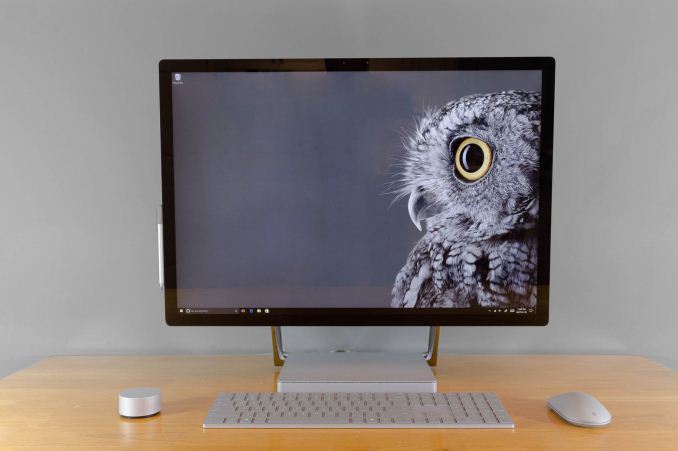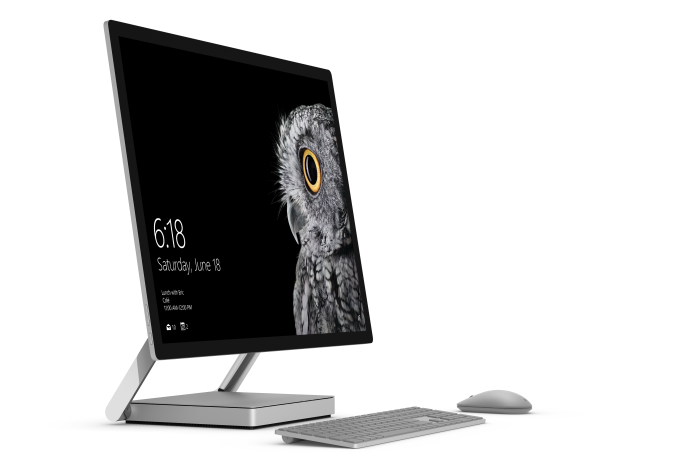The Microsoft Surface Studio Review
by Brett Howse on January 20, 2017 8:00 AM EST- Posted in
- Desktop
- Microsoft
- Surface
- Surface Studio

Microsoft has only been in the PC system game for a few years now, but over the last couple of years they have made a lot of progress rather quickly. These days they have a solid foundation of products available, with the Surface Pro 4 being one of the best convertible tablets, the Surface Book being a very solid convertible laptop, and also the more specialized products like the Hololens, and Surface Hub. Going into their October 2016 event, the one missing piece of their PC product lineup was a desktop computer, but with the announcement and release of the Surface Studio, that particular gap has now been filled.
But the Surface Studio is not your typical desktop PC. Even at first glance, the sleek, beautiful lines are readily apparent, and once powered on, it is rare for anyone to first glimpse the 28.125-inch 4500x3000 display and not say “wow”. It’s not only the very high resolution, but also the 3:2 aspect ratio that is unheard of in this segment, that makes the display stand out as something unique.
Microsoft has become one of the superlative hardware manufacturers in only the short span of four years or so, and the Surface Studio is one of their finest designs yet. However, from the very first Surface RT, Microsoft always tries to add something different, but more importantly interesting, to their designs, and in the case of the Surface Studio, it is the zero-gravity hinge, which allows the all-in-one to be quickly and easily tilted back to a 20° angle, letting it be used as a huge, digital drafting table. Microsoft announced the Surface Studio at their October Windows event, where they also announced the next Windows 10 Update, called the Creator’s Update, and it is wonderful to see them building hardware to truly bring out the exclusive features of their software.
Packed into the base of the Surface Studio is a laptop-class computer, with three different models available now. The base model, coming in at $2999, features an Intel Core i5-6440HQ processor, 8 GB of memory, a 1 TB hybrid drive with a 64 GB SSD cache, and a NVIDIA GeForce GTX 965M GPU. The mid-level model, which costs $3499, bumps the CPU up to an Intel Core i7-6820HQ, doubles the RAM to 16 GB, and doubles the SSD cache to a PCIe 128 GB model, with the same 1 TB HDD and GTX 965M. The highest priced model, at $4199, is an Intel Core i7-6820HQ, 32 GB of RAM, a 2 TB hybrid drive with a 128 GB PCIe cache, and a NVIDIA GTX 980M GPU with 4 GB of memory.
| Microsoft Surface Studio | ||||||
| Base | Middle | Top (As Tested) | ||||
| CPU | Intel Core i5-6440HQ Quad-Core, 2.6-3.5 GHz 6 MB Cache, 45W TDP, No Hyperthreading |
Intel Core i7-6820HQ Quad-Core, 2.7-3.6 GHz 8 MB Cache, 45W TDP, Hyperthreading |
||||
| GPU | NVIDIA GTX 965M 1024 CUDA Cores 944 Mhz + Boost 2 GB GDDR5 128-bit memory |
NVIDIA GTX 980M 1536 CUDA Cores 1038 Mhz + Boost 4 GB GDDR5 256-bit memory |
||||
| RAM | 8 GB DDR4 | 16 GB DDR4 | 32 GB DDR4 | |||
| Storage | 1 TB Hybrid Drive 64 GB SATA SSD Cache / 1 TB SATA HDD |
1 TB Hybrid Drive 128 GB PCIe SSD Cache / 1 TB SATA HDD |
2 TB Hybrid Drive 128 GB PCIe SSD Cache / 2 TB SATA HDD |
|||
| IO | 4 USB 3.0 ports - one high power port Full size SD Card Slot Headset Jack Xbox Wireless Connectivity DisplayPort |
|||||
| Display | 28.125-inch PixelSense Display 4500 x 3000 resolution 192 DPI sRGB, DCI-P3, P3 D65 color modes |
|||||
| Webcam | 5 MP Webcam Windows Hello Facial Recognition |
|||||
| Networking | Marvel AVASTAR 802.11ac Intel I219-LM Gigabit Ethernet |
|||||
| Price | $2,999 | $3,499 | $4,199 | |||
There was quite a bit of discussion at the time of the Surface Studio launch over the fact that it was equipped with older technology. Intel’s Kaby Lake quad-core parts just launched at CES this year, so Skylake quad-core CPUs were the latest generation available at launch. The Maxwell based graphics options chosen were not the latest generation mobile graphics from NVIDIA, with the GTX 965M and GTX 980M available in the Studio. The Pascal based GTX 1060 and GTX 1070 would have been much more powerful substitutes, but they are not pin-compatible drop-in components with the Maxwell GPUs in the Surface Studio, meaning a new board design and thermal considerations would have been necessary late in the design phase, and Microsoft appears to have been conservative here to avoid missing their launch window.
Microsoft has also been very conservative with their I/O choices, with four USB 3.0 Type-A ports on the back of the Studio, along with a SD card slot, and mini DisplayPort. As with the Surface Pro 4 and Surface Book, Microsoft has continued to provide only the older USB-A ports, and not even offer a single USB-C port, let alone with Thunderbolt. Anyone purchasing a Studio will likely be using it for several years, and the lack of USB-C is going to be an issue in the future, if not already today. The Surface team really needs to reconsider this as it is already a detriment to not include any.
There also must be some questions raised about the use of a hybrid drive in a PC of this price. We’ll dig in to the experience later, but Microsoft could and should offer a larger SSD as the boot disk, complimented by a HDD as a secondary disk, at least on the highest end model. A 512 GB NVMe SSD as the boot drive would appease much of the criticism. The computer does cost over $4000 after all, and while much of the cost of the device is in the display, SSDs have been the biggest improvement in user experience on the PC in a long time.











197 Comments
View All Comments
Valantar - Saturday, January 21, 2017 - link
"The most frustrating part of the Surface Studio base is that all the inputs and outputs are on the rear of the device, so connecting something over USB, or inserting a SD card into the PC, is not as simple as it should be. This is a form over function decision, and it would be nice to see some of the ports offered at least on the side of the base to make it a bit easier to access."Not quite form over function - the hinge mechanism and 20 degree angle would interfere with ports on all three sides (the hinges fold flat along the sides, and the display either touches the front or comes very, very close when folded all the way down. Cables, SD cards and the like sticking out would make this a hassle, and essentially break the functionality that is the core of this computer.
Brett Howse - Saturday, January 21, 2017 - link
Yes, it wouldn't work in the current design perfectly (although the SD card could easily be at the front) but regardless, having all of the ports on the rear makes it a chore to access them.Manch - Monday, January 23, 2017 - link
I saw that and thought a break out box would be nice. Of course that would make it less tidy, but having a bunch of cables run from around the backside worse.alkonaut - Saturday, January 21, 2017 - link
Is the motherboard and other hardware in the base, separate from the screen, meaning it could (at least in theory) be replaced while keeping the display?A display this good/expensive *has* to last at least 3 computers - so a definite no-go if it has to follow the motherboard/cpu/ram/ssd to the trash in 3 years!
Brett Howse - Saturday, January 21, 2017 - link
In theory, but unlikely this would ever be practicalManch - Monday, January 23, 2017 - link
I think we will see this with an upgraded base ala Surface Book. I doubt it will ever be user upgradeable which would be a nice. I don't know why people insist this will be in the trash in 3 years. Give it to me! If intels progress is any indication, you CPU will be good for a loooong time. Also for what this is designed for, I just don't see the applications out running the hardware anytime soon. With the Creators Update not out for a bit, I think they had enough time and should have went 1060/107 at least for the high end. Overall, a lust worthy machine. I don't need one, but damn I wouldn't mind having one.mobutu - Sunday, January 22, 2017 - link
I applaud the company for this obsessive attention to detail but what in the hell were they thinking fitting oldtech inside? thats just crazy and goes on the opposite spectrum of that obsessive attention to detail!-new cpu
-new gpu (lol, easily the BIGGEST mistake)
-ssd pcienvme only (I take a piss on their hybrid crap)
-in 2017, any computer should be dead silent while doing light workloads (browse, email etc). WTF they were thinking, designing this device with artists/creators in mind and giving them a noisy computer when they need SILENCE to be able to create properly!!!
-still big bezels on the otherwise wonderful display.
And LOL, ETA 6months for a GTX980??? thats gotta be a joke or something, when your "new" pc is arriving, that maxell is gonna be very ancient tech already, not just old!
As usual, wait for the next wave when they'll learn their lesson. Buying this now is kinda stupid.
mobutu - Sunday, January 22, 2017 - link
also, forgot about no usbc thinderbolt hdmi dp ... so connectivity also suffers in the curent implementationfanofanand - Monday, January 23, 2017 - link
Artists don't have a clue about anything you just wrote. They will just see the price tag and think "man this thing must be good" and will buy it. Do you really think the average artist knows the difference between a 965, a 980, and a 1080?nerd1 - Sunday, January 22, 2017 - link
So.. monitor is AWESOME and other parts are worse than $1500 laptop. Why doesn't they sell the monitor+touchscreen as a separate USB-C device, i.e. for $1500? I'd get one ASAP!